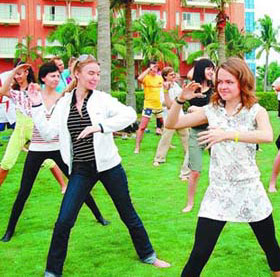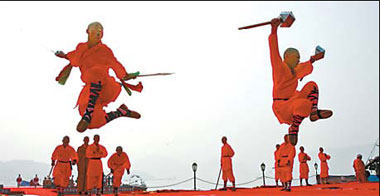|

Russian visitors learn Taiji from Chinese Kong fu master Zhang Maoguo, accompanied by Chinese folk music in Boao, southern China's Hainan Province on Saturday, Nov. 3, 2007. (Photo: hinews.cn)
|
Most foreigners get a kick out of Kung Fu, but most have a relatively superficial understanding of the ancient Chinese martial art form.
The word, which literally translates as "great achievement", at first meant to excel in any scholarly area - calligraphy, for example. But over time, kungfu became an umbrella term for Chinese martial arts, which can be cross-divided and subdivided in a confusing variety of often-overlapping ways.
Historians are unsure of Kung Fu's origins, but it is generally agreed upon that the Shaolin School originated in what is today Henan province, while Wudong came from what is now Hubei Province.
The Shaolin School is the better known of the two among foreigners, partly because its movements are much more flamboyant. It places greater emphasis on direct physical contact with the opponent and taking offensive measures.
Wudong, however, is more reserved, because it has a greater grounding in Zen tradition. Rather than focusing on wai gong (outward movements) it more often uses jing gong (inactive movements).
Monks from Shaolin Temple, Henan Province, demonstrate their kungfu.
According to Wudong techniques, practitioners should wait for their opponent to charge and then beat them to the punch. Shaolin Kung Fu, however, advocates charging to bring the fight your foe.
At its best, the jing gong practitioner's movements would be solely internal, with the practitioners' movements indiscernible as physical motion to onlookers or opponents. It is believed to be more difficult and time-consuming to master, but most experts in the field agree that it's far more effective. Reportedly, the real masters of this method can defeat an enemy with little or no visible movement.
There is also a division between what is known as the Northern School (bei quan) and the Southern School (nan quan) of kungfu. The Southern School uses more fists and other upper-body attack techniques, while the Northern School incorporates more kicks and leg sweeps.
However, the first rule of all kungfu schools is: "You should never fight, and should always strive for peace and harmony." And while the art form is today known overseas mostly for showy stunts, combat is only one of three parts that constitute the practice, which is at least equally focused on meditation and traditional Chinese medicine (TCM).
Today, kungfu is an umbrella term for a number of Chinese martial arts, including taiji, bagua, wushu, quanshu and boji.
Among these, wushu is best known among foreigners, mostly because its showiness makes it most appealing to filmmakers. The balletic nature of wushu, for example, made it the kungfu method of choice for Crouching Tiger, Hidden Dragon, which has become a well-known martial arts flick in the West.
Wushu was developed after the founding of New China, when the Administration of Sports gathered kungfu masters from around the country to standardize the martial art.
The result of their homogenized compilation of techniques was wushu. However, many practitioners from other schools criticize it for excluding the most important philosophical elements, such as TCM, Taoism, Buddhism and Confucianism.
(China Daily by Erik Nilsson February 18, 2008)



